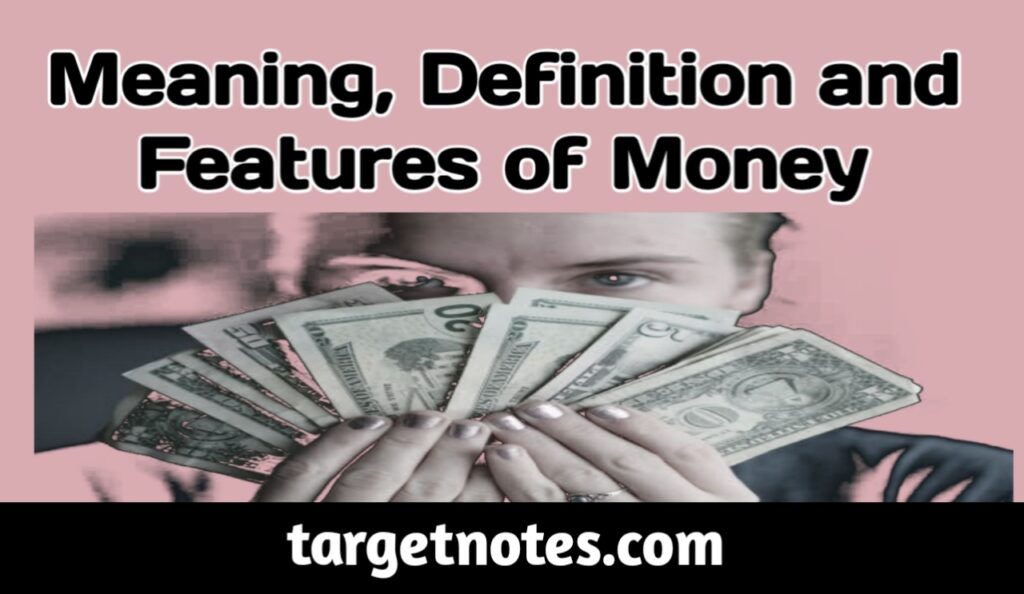
Money: Meaning, Definitions and features of Money
What do you meant by money? State the main features of money.
Contents
Meaning and Definitions of Money.
The term ‘money’ has been derived from Latin term ‘moneta’. Moneta is the another name of the Goddess Juno of Rome (Italy). In the ancient period this Goddess was the Goddess of heaven and coins were made in the temple of this Goddess. Thus the money manufactured in the temple of Goddess Juno was said as Moneta. After sometime it became ‘money’. In the view of some scholars term ‘money’ has been derived from Latin term ‘Pecunia’. Term ‘Pecunia’ has been taken from the term ‘Pecus’. Pecus means live-stock. In the ancient mostly animals were used a money in Rome so same meaning was treated of animals and money.
All those things can be money which are accepted as a source of exchange. It can be transacted by anybody. It is used as a source of exchange and measurement of value. It can also be used for the payment of things and as a settlement of debts.
The various definitions given by different eminent authors / scholars can be discussed by classifying as in the diagram:
Definitions as classified in the diagram are as under can be discussed as below:
(a) Definitions Based on Nature of Money:
The definitions based on nature money are as under:
1. Functional or Descriptive Definitions of Money: These definitions point out the features and functions of money.
According to Hartley Withers, “Money is what money does.”
According to Whittlesey, “If a particular unit is commonly employed to state values, exchange goods and services, or perform other functions, then it is money, whatever its legal or physical characteristics.”
All definitions mentioned above describe the functions and features of money but do not explain the nature of money. These are not scientific definitions.
2. Legal Definitions of Money: These definitions of money are as under:
According to Prof. Hawtrey, “There are two aspects of money- firstly, unit of account and secondly, legal tender.”
According to Prof. F. Knapp, “Anything which is declared money state, becomes money.” by the The above mentioned legal definitions explain the legal viewpoint regarding money.
3. Definitions based on Common Acceptability of Money: The central point of these definitions is general acceptability:
According to Ely, “Money consists of those things which within a society are of general acceptability.”
According to Seligman, “Money is one thing that possesses general acceptability.”
According to Kent, “Money is anything which is commonly used and generally accepted as a medium of exchange or as a standard of value.”
According to D. H. Robertson, “Money is a commodity which is used to denote anything which is widely accepted in payment of goods or in the discharge of other business obligations.”
(b) Definitions based on Approach or Viewpoint of Scholars (Economists):
These definitions are as under:
1. Narrow Definitions: These definitions narrow down the scope of
According to Price, “Coins, metallic coins, are alone true money.”
2. Broad Definitions: Definitions falling under this category are as follows:
According to Hartley Withers, “Money is what money does.”
According to Karl Helfferich, “We understand, therefore, by the term money, the complex of their objects, which in a given economic area and in a given economic system, have as their normal purpose of the facilitation of economic intercourse between economic individuals.”
In the viewpoint of the above definitions all those things are money which execute the functions of money. Money comprises metallic coins. currency notes, cheques, bills of exchange, hundies, etc.
(c) Suitable or Ideal Definitions :
According to this viewpoint the following definitions are as under:
According to J. M. Keynes, “Money is that delivery of which debt contracts and price contracts are discharged and in the shape of which a store of general purchasing power is held.”
According to Alfred Marshall, “All those things which are at any time and place generally current without doubt or special enquiry as a means of purchasing commodities and services and of defraying expenses included in the definition of money.”
Features of Money –
Above definitions show general acceptability of Following are salient features of money:
- Voluntarily accepted.
- Medium of exchange and standard of value
- Accepted in general by all.
- A medium of exchange
- A standard of value
- A store of value
- A commodity having common acceptability by community.
Related Link
- Describe the various types of money
- Dynamic Functions of Money
- Evils or Demerits of Money
- Importance and significance of money in Modern Economy
- Approaches regarding Definitions of Money and its Function
- Money: Meaning, Definitions and features of Money
IMPORTANT LINK
- What is the Exchange Rate System in India?
- Evolution of foreign exchange market in India
- Meaning and importance of export finance.
- Role of Export-Import Bank in Financing India’s Foreign Trade
- How Commercial banks Export Finance to Overseas Importers?
- Explain packing credit in detail?
- What is Post-shipment credit?
- What is Pre-shipment or packing credit?
- Explain Export Credit in India?
- Institutions Providing Finance and Credit Facility for Foreign Trade
- What is Risk Analysis?
- Explain Political risks in detail? and its Types
- What are the types of Risks. Explain in detail?
- Meaning and Types of commercial risks
- How can we minimize foreign trade risks?
- What are Arbitrage operations?
- Difference between Spot Market and Forward Market
- What is spot exchange?
- Agency agreement: Meaning, Features and Advantages
- Functions of Foreign Exchange markets
- structure of Foreign exchange markets
Disclaimer




